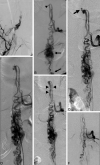Spinal arteriovenous metameric syndrome: clinical manifestations and endovascular management
- PMID: 22859288
- PMCID: PMC7965096
- DOI: 10.3174/ajnr.A3212
Spinal arteriovenous metameric syndrome: clinical manifestations and endovascular management
Abstract
Background and purpose: SAMS is a rare form of SCAVM. We discuss the clinical presentation, endovascular management, and outcome of this disease in our series.
Materials and methods: Retrospective review was performed in patients with SCAVM and SAMS who underwent angiography with intent to treat at our institution from 1980 to 2010.
Results: One hundred forty-eight SCAVMs were identified, and 28 (19%) of these were SAMS. Of these 28 patients, 24 had nidus-type AVMs and 4 had fistulas. SAMS were more prevalent in females (71% versus 48%), and also presented earlier than non-SAMS SCAVMs. Intradural hemorrhage (SAH or hematomyelia) was the most common presentation and more common than in non-SAMS lesions. Twenty-six patients underwent embolization of the intradural lesion in 50 sessions. Thirteen patients underwent treatment of intradural aneurysms in 16 sessions. Six patients underwent embolization of extradural lesions in 16 sessions. Twenty-three patients had an average of 94 months of clinical follow-up (3-309 months) after the first treatment, during which 5 patients had hemorrhages. Angiographic follow-up was performed in 20 patients at an average of 85 months (range, 3-309 months), which showed new development or enlargement of an aneurysm in 5 patients. This type of angiographic progression was more common in patients with SAMS.
Conclusions: SAMS most commonly presents with hemorrhage from the SCAVM. Endovascular embolization can be performed safely with good functional outcome, though most patients clinically deteriorate in the long term. Periodic angiographic follow-up with intent to perform preventive target embolization is important to control the disease.
Figures


References
-
- Aminoff MJ, Logue V. The prognosis of patients with spinal vascular malformations. Brain 1974;97:211–18 - PubMed
-
- Spetzler RF, Detwiler PW, Riina HA, et al. . Modified classification of spinal cord vascular lesions. J Neurosurg 2002;96:145–56 - PubMed
-
- Berenstein A, Lasjaunias P, ter Brugge K. Spinal arteriovenous malformations. In: Berenstein A, Lasjaunias P, ter Brugge K. Surgical Neuroangiography. 2nd ed. Berlin, Germany: Springer-Verlag; 2004:737–847
Publication types
MeSH terms
LinkOut - more resources
Full Text Sources
Medical
